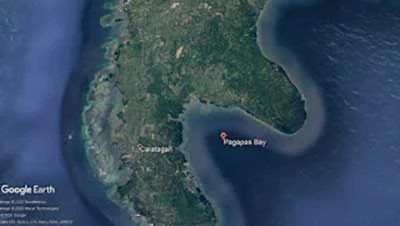When Balayan Guerrillas Stole Japanese Q-Boats from a Base in Calatagan in WWII
Towards the end of 1943, when the tides of war in the Pacific had started to turn in favor of the Allied Forces, Japan started to explore alternative and extreme weapons that involved the sacrifice of the lives of their own fighting men. Airplanes would be heavily laden with explosives and deliberately crashed by their pilots into Allied ships, a sacrifice that the Japanese called the kamikaze or “divine wind1.”
At sea, meanwhile, the Japanese Imperial Navy would soon deploy the Shin’yō, or “Sea Quake” fast motor suicide boats which, like the kamikaze, were heavily rigged with explosives which could be set off using a switch by the boat’s lone pilot or upon impact with enemy vessels2. The Allied Forces called these suicide vessels the “Q-boats,” and these were used operationally by the Japanese primarily in the Philippines.
In late 1944, the Japanese Navy maintained a base of these Q-boats at Pagaspas Bay near the barrio of Bucal in the Municipality of Calatagan3. Because the Allied Forces had impending invasions of Luzon at Lingayen Gulf and Nasugbu planned for January 1945, it goes without saying that this and other Q-boat bases in Batangas were a source of concern.
As part of the strategy leading to the aforementioned invasions of Luzon, the Allied Forces had by December 1944 set up air and naval bases in the southwest corner of Mangarin Bay near the town of San Jose in Mindoro4.
It was at the Allied naval base that one Major Buenaventura de Guzman5 of the Pioneer Balayan Town Guerrilla Unit of the Fil-American Irregular Troops (FAIT) [Refer to important annotation number 6 under “Notes and References6” below.] informed one “Commander Davis” [Refer to important annotation number 7 under “Notes and references7” below.] of the United States Navy of the presence of the Q-boat base at Pagaspas Bay.
De Guzman was requested by Davis to accompany the raiding party that was immediately planned to seek and destroy the base — presumably as guide — something to which the former agreed. Presumably, de Guzman was also given the mission of stealing Q-boats, likely for intelligence purposes.
The following day, he and his men spent the entire time stealthily observing movements inside the Japanese Q-boat base. Noting that it would be impossible to approach the base by land, de Guzman devised a plan involving approaching the base by sea.
When nighttime came, de Guzman took five of his men and started walking from San Pedrino Point naked with ropes tied around their bodies. Upon reaching barrio Bucal, they started swimming for the base under cover of darkness. Because the Q-boats were made of wood and, therefore, light, the guerrillas presumably snuck up close to tie them up and then pulled them away using ropes from where they were kept.
Before long, in complete stealth, they had managed to whisk away two Q-boats back to San Pedrino Point, where US Navy PT boats would arrive at three in the morning the next day to take these to the facility at Mangarin Bay in Mindoro. Mission accomplished, de Guzman would stay with his men at barrio Baha in Calatagan for two days before setting out for Mindoro on board a banca to report to Davis about Japanese gun emplacements and positions in the town of Balayan.
The raid to destroy the Q-boat base would not be undertaken until the next month, with de Guzman officially designated by Guerrilla Coordinator Lt. Commander George F. Rowe of the United States Navy as guide. PT boats were used in the raid, supported by two B-25 fighter/bomber and three P-38 fighter planes.
Japanese losses were heavy, with an estimated 350 officers and enlisted men killed. Moreover, some 50 Q-boats were totally destroyed during the raid, which lasted less than an hour. This was no small matter, because before long convoys of Allied ships would be passing by on their way to Lingayen Bay and, later in the month, Nasugbu.
Notes and references:
1 “Kamikaze,” Wikipedia.2 “Shin'yō-class suicide motorboat,” Wikipedia.
3 Unless otherwise specified, most of the important information contained in this article has been taken from “A Brief History of the Pioneer Balayan Town Guerrillas FAIT,” taken from “Pioneer Balayan Town Guerrillas, Deguito Unit FAIT,” File No. 110-42, downloaded from PVAO.
4 “The War in the Pacific: Triumph in the Philippines,” by Robert Ross Smith, online at Ibiblio.org.
5 The rank of Major carried by de Guzman was a guerrilla rank. When he was given official recognition by the United States Army after World War II for his role in the days leading to and after the invasion of Luzon, his assigned rank was that of a Lieutenant.
6 The Pioneer Balayan Town Guerrilla Unit, FAIT submitted a roster well in excess of one thousand members for official recognition by the United States Armed Forces after the conclusion of WWII. Of this large list, only a core group of 42 apparently under the leadership of Buenaventura de Guzman and Julian Tesorero was given recognition as having been an element of the Philippine Army in the service of the United States Armed Forces during the liberation of the Philippines.
7 The Commander Davis referred to in the Pioneer Balayan Town Guerrillas’ historical document must have been Lt. Commander N. Burt Davis Jr., commander of PT (short for “motorized patrol torpedo boat”) Boat squadrons 13 and 16. “At Close Quarters: PT Boats in the United States Navy,” by Capt. Robert J. Bulkley, Jr., published in Washington DC in 1962, online at Ibiblio.org.


